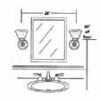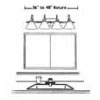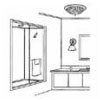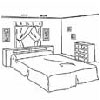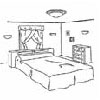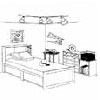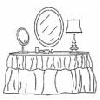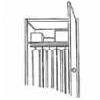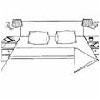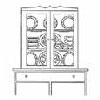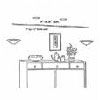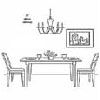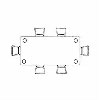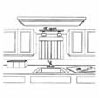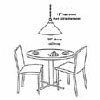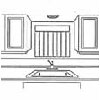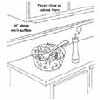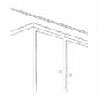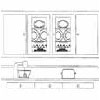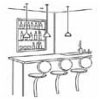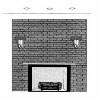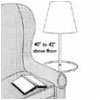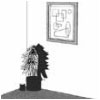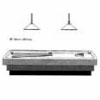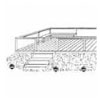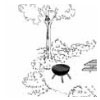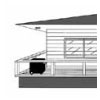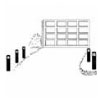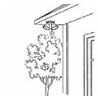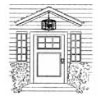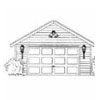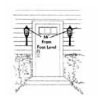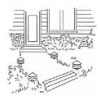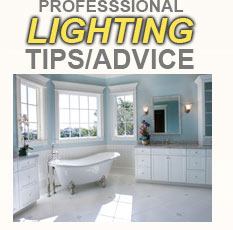
Decorative sconces, chandeliers, table and floor lamps in a variety of shapes, styles and finishes elevate a room from drab to dramatic with the flick of a switch. While traditional, polished brass fixtures still form the central core of the decorative lighting business, learn about the variety of options that have become more important in recent years.
Ceiling fans that cool the air in style
Want to stir things up around the house? Add a ceiling fan. It's true - stirring up the air will make you feel immediately cooler. But ceiling fans do more than just bring about breezes. Designed with the latest home decor trends in mind, these overhead fans move in fashionable circles. Read about the new designs and technology now available.
Decorating with Light
The wallpaper is up. The drapes are hung, and the furniture is in place. But something is missing. Decorating is not complete without a selection of stylish lighting to seamlessly finish the look. Learn how to decorate with lighting.
Dimmers Set a Lighter Mood
What's the fuss? You walk into a room; flip a switch. Light. You walk out; flip. Dark. Sure, it works, but you may be missing the big picture. Lighting isn't just there to make sure you don't trip over the shoes in the middle of the floor. With a few easy changes it can enhance the decor of any room and set a mood...
Brightest Trends in Decorative Lighting

In December 2007, the Energy Independence and Security Act of 2007 (EISA) was signed into law by President Bush. This law contains new energy efficiency standards for the lighting industry. Standard incandescent lamps are not being outlawed but rather changed to save energy. For residential consumers, the law will affect commonly used "A" lamps such as 40, 60, 75 and 100 watt bulbs, as well as reflector style lamps. Fluorescent lamps and ballasts will also be affected, but not as drastically as the incandescents.
For the "A" lamps the EISA legislation requires an approximate 30 percent increase in efficiency starting in 2012. Efficiency of light bulbs is measured in lumens/watt of energy consumed and is stated as its efficacy. The net result of EISA will be a reduction in lamp wattage. However, the amount of light produced will be roughly comparable to today's higher wattage lamps. The new standards are as follows:
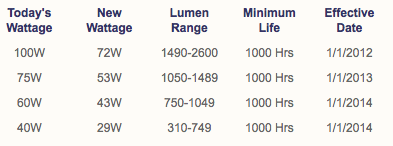
Most of the specialty and decorative lamps such as candelabra based bulbs and 3-way lamps are exempt from EISA.
Incandescent reflector style lamps including all R20, R30, R40, PAR20, PAR30, PAR38, BR30, BR40, ER30, ER40, and BPAR must meet specific Halogen efficiency levels except:
- Lamps rated at 50 watts or less that are ER30, BR30, BR40, or, ER40 lamps.
- Lamps rated at 65 watts that are BR30, BR40 or ER40 lamps.
- R20 incandescent reflector lamps rated 45 watts or less.
Linear fluorescent fixtures using 2', 4' and 8' T12 lamps and electromagnetic ballasts are being replaced by fixtures containing T8 lamps and electronic ballasts. Electromagnetic replacement ballasts cannot be manufactured after July 1, 2010. The cutoff for manufacture of the common 2', 4' and 8' T12 lamps will occur in July 2012.
Ceiling fans that cool the air in style
Want to stir things up around the house? Add a ceiling fan.It's true – stirring up the air will make you feel immediately cooler. But ceiling fans do more than just bring about breezes. Designed with the latest home decor trends in mind, these overhead fans move in fashionable circles.
"Fans today are design pieces as well as functional appliances," says Patrick Wilson, vice president, sales and marketing for Minka Aire, a ceiling fan manufacturer based in Corona, CA.
John Pearson agrees. "Customers are interested in using fans as design elements," says the vice president for marketing for Casablanca Fan Company, a Pomona, CA.-based fan manufacturer.
New finishes get the thumbs-up
High-tech, contemporary designs have become popular in the last few years. As a result, brushed nickel, steel, and sleek pewter finishes get thumbs-up approval from trendsetters. Earth tones like rustic copper and bronze are also hot-sellers. Ditto painted finishes and washes.
"People are more inquisitive than ever about ceiling fan possibilities," says Troy Lee, general merchandising manager for Progressive Lighting, Inc., a retailer in Kennesaw, GA. "People want something attractive on their ceiling and they are concerned about matching the fan's design to their decor."
Fans in all designs
Ceiling fans work well in any home, thanks to a variety of design options. Ornate filigree blade holders offer a graceful, turn-of-the-century ambience. Brushed steel housing and light-colored maple blades offer the ultimate in contemporary styling. Classic polished brass finishes work well in more traditional homes.
"Today's fan customer seems less interested in price and more concerned about matching their ceiling fan to their home décor. I think it's great to offer a product that makes a home more comfortable and adds beauty at the same time," said Cliff Crimmings, vice president of marketing, Craftmade, a fan manufacturer from Coppell, TX.
More power for larger spaces
The soaring ceilings and expansive great rooms in today's newer homes have increased demand for larger fans with bigger blades and longer down rods. Manufacturers comply, creating phenomenal fans that move massive quantities of air and work well in 30-foot tall spaces and lofts.
Fan design isn't the only thing that's expanded. Places to put ceiling fans have also increased. These fans bring a breeze to almost any home space, inside or out -- from kitchens, bathrooms and dining areas to porches, patios and gazebos.
Fans for outside rooms
"We are seeing more fans being used on patios than ever before," says Kathy Held, manager, buyer and vice president of South Dade Lighting, a 10,000 sq. ft. lighting showroom in Miami, FL. "People are using their porches and patios as extra rooms. They spend money on landscaping and landscape lighting, then add the fans so they can sit out and enjoy it all."
Adding light
With more than 14 million ceiling fans sold annually, most do double-duty, lighting a room as well as moving air. "Our research indicates that a majority of ceiling fans are sold with a light fixture because consumers are usually replacing a light in their room," says Mark Jeffrey, general manager for Emerson Electric Company Air Comfort Products Division, a St. Louis, MO., manufacturer.
Little wonder. Ceiling fans today offer a wide variety of lighting options that add interest to any home. Mission-inspired fans look great with mica or stained-glass light fixtures. Art Deco styles boast white frost fixtures for a clean look. Glass shades etched with flowers add a romantic touch to a little girl's room.
"Ceiling fans have become an important part of the lighting scheme in homes today," says Held, who often works with customers to combine recessed and decorative lighting with ceiling fans.
Some fans feature built-in lighting. Others work with light kits, allowing dwellers to mix-and-match light fixtures and fitters to create a customized look.
When choosing lights for your ceiling fan, be sure they meet the room's needs. Workspaces like kitchens and home offices demand bright light. Bedrooms and dining rooms, however, require more subdued illumination. Dimmer switches also allow you to adjust the light on a fan to fit your mood.
To create more relaxed lighting, consider the latest introduction -- ceiling fans with indirect uplighting. "The uplight bounces ambient light off the ceiling to create a comfortable mood," says Jeffrey. Emerson debuted uplighting last year, combining it with more traditional downlighting in several models this season.
You're in (remote) control
Like garage doors and television sets, some ceiling fans utilize remote controls to not only adjust lights, but operate the fan itself.
"Everything else has a remote, why not a ceiling fan?" says Casablanca's Pearson.
Tall ceilings and aging Baby Boomers make remotes a good idea. "The older population and couch potatoes don't want to jump up and down to pull a chain on a fan," says Minka Aire's Wilson.
In addition to turning fans on and off, some remotes automatically adjust the fan based on changes in the room's temperature, turn lights on and off when you're not home and dim lights as you leave the room.
Quality equals quiet
Ceiling fan prices are as diverse as the styles. Experts agree, however, that quality counts.
"Customers are more educated than ever about the different grades of fans," says Allan Margolin, president of M&M Lighting, Inc., a Houston, TX., retail establishment. "Fans can cost up to $600 for a quality, deluxe model at a lighting showroom. Customers seem to be turning to the lighting showrooms and trading up to better merchandise, replacing ceiling fans that wobble, make noise and don't move air as well as top quality fans."
In fact, independent research from the American Lighting Association (ALA) indicates that 70% of consumers do not mind paying more for a higher quality product. The ALA points out that consumers will have the ceiling fan for many years so quality and style should be key factors in the buying decision.
CEILING FANS & ENERGY EFFICIENCY
Ceiling fans don't actually lower the temperature of a room like an air condition. But by spinning the air, they do make the room feel cooler.
"Ceiling fans augment air conditioning by moving air and creating a wind chill effect," says Patrick Wilson, vice president, marketing for Minka Aire, a ceiling fan manufacturer based in Corona, CA. "If your air conditioner is set at 72, the wind chill factor of the fan will make it feel like 68 degrees."
Best of all, ceiling fans use only about as much energy as a 100-watt light bulb. Studies show that by setting ceiling fans to spin in a counter-clockwise pattern, you can save as much as 40% off summer cooling bills -- without sweltering. Simply set the thermostat a few degrees higher and flip on the fan.
Fans in winter?
In the winter, ceiling fans move warm air back to the center of the room, pushing it down from the ceiling. "With tall ceilings, it can be 10-15 degrees hotter up there than on the floor," says Wilson. "Ceiling fans can push that warm air back down to floor level."
Studies also reveal that ceiling fans can help homeowners save as much as 10% on their heating bills. Switch the direction of the blades to spin clockwise and turn on the fan.
Content courtesy of the American Lighting Association. Please visit their site at www.americanlightingassoc.com for more information.
10 TIPS FOR BUYING A CEILING FAN
Finding the fan that works best for your home is a breeze, when you follow the expert's advice.
Bigger rooms need bigger fans. Choose a 50-to 56-inch fan for rooms up to 225 sq. ft. and larger. Pick up a 42-to 44-inch fan for rooms up to 144 sq. ft. Rooms up to 64 sq. ft. can use a 32-inch fan.
Ceiling height is also important when choosing a fan. For safe operation, fan blades should be at least seven feet above the floor. A blade height of eight-nine feet is optimum.
Look for a motor that can do the job. "The heart of the fan is its motor," says Mark Jeffrey, marketing manager for Emerson Electric Company Air Comfort Products Division in St. Louis, MO. "You can't see it but it is the real workhorse." The amount of air moved by a ceiling fan depends on the angle, or pitch, of its blades. A pitch of 14 degrees is optimum for maximum air movement.
Consider your home's style. "If you want the fan to be part of your home's decor, look for colors and detail that complement," says Casablanca Fan Company's John Pearson. "If you want the fan to "disappear," choose one the color of the ceiling."
Look for light fixtures and fitters that match your fan's finish. Ceiling fans run on electricity. Determine if you will need electrical wiring brought to the part of the room you want to add the fan. Since most fans replace existing lights, the wiring is usually already in place.
When adding a fan to the bathroom, look for one specifically designed and UL-listed for damp locations. Want one for the patio? Opt for a fan that is UL-listed for wet locations.
"A ceiling fan is only as good as the company who sells it to you," says Kathy Held, manager, buyer and vice president of South Dade Lighting, a 10,000 sq. ft. lighting showroom in Miami, FL. "Look for someone who will be able to help and service you."
Buy the best quality you can afford. "People are willing to spend more money to achieve quiet operation, better performance and a look that complements their home decor," says Ball.
Decorating with Light
The wallpaper is up. The drapes are hung, and the furniture is in place. But something is missing. Decorating is not complete without a selection of stylish lighting to seamlessly finish the look.
There was a time when lighting did not have the decorating value that it has today. The choices were few and the styles limited. Now, consumers can find a floor lamp, table-lamp, chandelier, pendant or sconce to fit their décor, no matter the room.
"The industry has evolved," says Monty Gilbertson, CLC, manager and buyer for Lighting Design by Wettstein's in Lacrosse, WI. "There was a time 10 to 12 years ago when lighting was in a rut. In the last few years—really five to eight—it has turned almost into more of an apparel-type market … where on a year-to-year basis there can be some hot spots. There are a lot of new looks every year."
Today's looks follow several major developments as stated by experts of the American Lighting Association (ALA).
Softer metals
This year has brought with it a diverse selection of softer metallic finishes. Brushed nickel, stainless steel, pewter, even brushed copper, have done their best to dethrone brass as the top finish choice. The softer tones of these gray metals make it easier for a lamp to blend with a multi-toned interior, according to Dan Blitzer, the American Lighting Association's technical lighting consultant.
Painted finishes
The availability of multi-toned colored finishes offers consumers lamps with more depth and texture—a trend that has come about from the joining of style and technology. Manufacturers now have the ability to elegantly apply layers of color to create the finish. The resulting look fits well with traditional styles and allows the fixture to blend with many colors in a room. Expect to find colored finishes with a soft tone that may include gold or silver flecks and tones of brown and red. Don't forget about white, too, says Gilbertson. Textured white finishes are also widely popular.
More authenticity
Developing hand-in-hand with painted finishes, are weathered finishes and patinas, which offer a unique, timeless look. "This is the next antique brass," says Gilbertson. "It's a soft, traditional look." The style has become more distinguished and authentic with changing technology. "[This finish] enables you to combine contemporary lighting with traditional furnishings, without having to resort to a formal, traditionally-styled chandelier, which may be too heavy visually," says Blitzer.
Many of the painted finishes look so much like an original weathered finish that the consumer won't be able to tell, says Todd Langner, vice president of marketing and product development for Kichler in Cleveland, OH. "The whole array of darker, richer bronzes is still very, very strong," he says.
Better detail
"Today's fixtures are more refined," says Blitzer. "There's more attention to detail." Nearly every aspect of the lamp, from the base to the pull chain, has earned more decorative detail, giving the lamps greater sophistication. Small details have increased the volume of choices for the consumer and have made it easier for the buyer to find a distinct style for their home.
"A lamp should be as interesting and as pretty without the light," says home furnishings and lighting designer Sergio Orozco, owner of Sergio Orozco Designs Inc., in West New York, New Jersey. "That is the ultimate objective. That way, it is an accessory. The objective here is to make each luminary a piece of architecture."
Top It Off
It isn't possible to consider the weight of lighting in home décor without considering one the lamp's most decorative features—the lampshade. It, too, has evolved from the days of limited choices.
"Lampshades have gone bonkers," says Gilbertson. "There are all these eclectic shades. It has just exploded."
Shades have taken on a more decorative look with a variety of shapes, fabrics, and adornments. Materials from metal and paper to tapestry and sheers have made it onto shades. Beads, stones, wire, fringe, and myriad accoutrements create an added flare to many designs. Nearly anything—within safety guidelines—can be found atop a lampshade.
"We're all designing in a tremendous amount of additional detail," says Langner. "That does include a lot of hanging ornaments on the shade, whether it is crystal or beads or whatever … It's been a growing trend for several years."
No longer is the A-frame shade the only choice, either. Certainly, the off-white silk shade in its traditional form is available, but why stop there when you can customize a lamp with shades shaped in cylinders, spheres, rectangles, and squares. Many shades are also designed to fit uniquely with the lamp's overall design.
"If [manufacturers] don't have unique shades today, [they] are off, off the market," says Orozco. "The development of techniques and technology has taken [designers] outside of the square box. It's developed into a trend that has become fashionable. And, now I think it has become an art form."
How do you choose?
When it comes to decorating a home, lighting certainly can't be left out. A well-chosen lamp may make all the difference. And finding the right one shouldn't be too difficult.
"Lighting has changed dramatically," says Gilbertson. "And, of course, it does a dramatic thing for your house. [Remember], it is how it's done that can make a world of difference."
Content courtesy of the American Lighting Association. Please visit their site at www.americanlightingassoc.com for more information.
TIPS when shopping for decorative lighting
Find an ALA Certified Lighting Consultant (CLC). He or she can make sure that you choose, not only a great decorative lamp, but also one that serves its purpose of lighting the space properly.
Bring in an example. A picture from your favorite magazine can make it easier for a salesperson to visualize your needs. Know your budget. The costs of lighting vary; so remember to keep an open mind in case the pendant you're in love with would break the bank.
Bring in swatches, paint chips, and other examples of the room where the lamp will be located. That will make it easier to coordinate with your décor.
If you can't find exactly what you want, consider having it custom made. Many lighting companies can do that for you.
Back to the Basics
Even when you're decorating, it is important to consider the practical purpose of the lighting in each room. Choose a light that offers you the best ambient or overall lighting, task lighting, and accent lighting based on your needs. Here's what you can expect from some of the most popular fixtures:
Ceiling fixtures are best used for general lighting. Chandeliers also create a general lighting atmosphere.
Dimmers can add drama to any room featuring a chandelier. Don't be restricted to using this fixture in the dining room. They are also ideal in a bedroom or living room. Some may also have downlights to offer task lighting.
Hanging fixtures, such as those used in a foyer, will offer general lighting that will create a comfortable level of lighting.
Pendants are a versatile way to create task or general lighting. Although mostly seen in kitchens, consider hanging several pendants at various heights over your favorite reading chair for a stylish accent.
Portable lamps will create general, task, and accent lighting, but have the added bonus of being mobile. Table lamps, floor lamps, and torchieres come in all shapes and sizes to complement any style.
Recessed lighting hides away in your ceiling while offering general, task, and accent lighting. Although not the most stylish collection of lighting, using recessed lighting may allow you more options for the rest of your lighting needs.
Track lighting is flexible enough to offer each form of lighting and has become a very stylish choice. You can rotate, swivel, and aim individual fixtures to meet your needs as they change.
Wall-mounted fixtures will provide general, task, and accent lighting. The number of choices for such fixtures makes them an ideal way to add style to a room.
Dimmers Set a Lighter Mood
What's the fuss? You walk into a room; flip a switch. Light. You walk out; flip. Dark. Sure, it works, but you are missing the big picture. Lighting isn't just there to make sure you don't trip over the shoes in the middle of the floor.
"With a few easy changes it can enhance the décor of any room and set a mood unique to any situation. And, it can save money in the process," said Larry Lauck, vice president, communications for the American Lighting Association in Dallas, Tex.
Dimmers for control
"Dimmers give us complete and intimate control over our lighting systems," says Dan Blitzer, the American Lighting Association's consulting director of continuing education. "I say complete because it allows us to adjust the intensity of the light to meet the needs of different individuals and different tasks, to warm the color, and to extend the life of incandescent lamps."
Such control allows the homeowner to set a mood in any room, not just the dining room. Adjusted lighting is ideal in a living room, bedroom, bathroom, and breakfast nook—nearly anywhere. The only rooms that may not benefit from dimmers are laundry rooms, storage areas, and pantries. Basic dimmer controls are simple to install in any existing or new setting, but there is more to the dimmer than the common knob-style.
"As a category, lighting control is virtually unknown," says Suzanne Miller, manager of public relations for Lutron in Coopersburg, Pa. "But not being able to control your lights is like not being able to control the volume on your TV, or the temperature in your oven. People want choices, they want control—and that includes being able to control lighting levels in their own homes."
Lighting controls come in four different types:
- Integrated dimming systems allow the most variety. Homeowners can create several preset lighting settings in a single room. With the touch of a single button from a wall box or a wireless remote control, they can recall the pre-selected scenes.
- Touch dimmers create a lighting change with the press of a single button. One-touch recall allows the homeowner to return to the previous lighting level without resetting the light. Some dimmers also have a lighted indicator to show the intensity of the current setting.
- Slide dimmers offer manual control of the lighting in a room. Some also include a button on the plate so it is easy to return to the previous setting.
- Rotary dimmers are the ones most likely to conjure images of your Mom's dining room. The manual dial allows a homeowner to alter the lighting level by turning the dial. Some have push-button control to switch the light off while keeping the current setting in place.
- It is also possible to control the lighting in your entire home by building in a custom system. This is the most cost-effective route, but it is possible to add a whole-house lighting system to an existing home. Wireless, infrared systems, and radio wave dimmers are available, and can go with you when you move. Another easy way to add the control of dimmers is an extension cord dimmer, which is a quick way to alter the light level of individual lamps.
"Every incandescent light in your home should be connected to a dimmer," says Lauck. "Just so that you can get the benefits of installing the light the way you want it and take advantage of a dimmers ability to extend lamp life."
Dimmers save money
A dimmer's operation is fairly simple. It essentially limits the amount of electricity that goes to the light. Less electricity means lower electrical costs. Using a lower wattage bulb can do the same thing but will not allow any lighting flexibility.
"The end result is you use less electricity," says Miller. "Dimming a light 10 percent cuts electricity usage by 10 percent and [that] generally has a direct correlation to cost. What's more, the human eye adapts to light so easily that you probably wouldn't even notice a 10 percent decrease."
Drama + convenience + comfort
Dimming controls will also extend the lamp's life, which will save you cash over time. It can also save you the hassle of replacing bulbs in hard-to-reach places.
"I think the real benefit is to lamp life," says Penny Henderson-Maher of Garland, TX, Lightolier's regional control specialist for the Northeast. "By dimming the light somewhat and turning it on with a soft fade, the lamps last a long time, like 3 to 4 years on a lamp that would normally last 6 months. That's really convenient because the light bulb always blows out when you don't have a spare.
"It's all sorts of drama, convenience, and comfort, and energy, and lamp savings all wrapped into one," she says.
Easily change your lighting environment
Jenny and Clayton Reid of Lenexa, KS recently moved into a new house fitted with integrated dimmer controls in the main areas of their custom-home. "The architect suggested them because we had a vision for the lighting and we knew it'd look great with dimmers," Jenny says. "I really like how they fade out."
Light can dictate the activity in the room it is illuminating, according to Henderson-Maher. Bright light creates motion and a lot of activity. It's ideal for getting everyone going in the morning, but not for relaxing. For that, or if an intimate party is what you have in mind, keep the perimeter of the room a bit darker. The "campfire effect" will draw people to the brighter area at the center of the room. Trying to get folks to mingle at a large gathering? Brighten the accent lighting around the perimeter. It will encourage people to move around.
Experiencing the environments varied lighting can create is really the key to understanding its importance in a room's décor.
"It is one thing to say dimmers create an ambience," says Miller. "And it is another to see it for real. Why settle for 'on' and 'off' when you can have 'on,' 'off' and everything in-between?"
Content courtesy of the American Lighting Association. Please visit their site at www.americanlightingassoc.com for more information.
Saving Energy
Dimmer controls are not the only way to help save energy in your home. Here are a few other ideas from the American Lighting Association:
- Be sure to turn off lights when you are not using them.
- Keep your outdoor lights energy-efficient by using timers to turn them on and off automatically. Or, choose lighting with photoelectric cells.
- Select bulbs with the more efficient reflector bulbs, especially in task and accent lighting applications. (For example: An energy efficient 50W "R" bulb will emit as much light onto an area as a 100W "A" bulb.)
- Fluorescent bulbs get more bang for their buck. The new compact fluorescent bulbs (CFLs) produce more light out of the electricity they use than their incandescent partner does, so consider installing these lights wherever applicable. Now more versatile than ever, CFLs can produce light color that is more similar to their warmer siblings. They are also available to accommodate a wide variety of lighting styles and functions.
ARTICLES
Ceiling Fans That Cool the Air in StyleWant to stir things up around the house? Add a ceiling fan. It's true – stirring up the air will make you feel immediately cooler. But ceiling fans do more than just bring about breezes. Designed with the latest home decor trends in mind, these overhead fans move in fashionable circles. Read about the new designs and technology now available.
Decorating with Light
The wallpaper is up. The drapes are hung, and the furniture is in place. But something is missing. Decorating is not complete without a selection of stylish lighting to seamlessly finish the look. Learn how to decorate with lighting.
Dimmers Set a Lighter Mood
What's the fuss? You walk into a room; flip a switch. Light. You walk out; flip. Dark. Sure, it works, but you may be missing the big picture. Lighting isn't just there to make sure you don't trip over the shoes in the middle of the floor. With a few easy changes it can enhance the décor of any room and set a mood…(read more)
Landscape Lighting Design Ideas
to showcase your home Outdoor lighting used to be simple. A wall lantern by the front and back doors, and maybe a post light by the driveway. Not anymore. When it comes to the great outdoors, homeowners have seen the light. "Today, the biggest excitement in outdoor lighting is the whole artistic aspect," says Dan Blitzer, education consultant for the American Lighting Association.
Layered Looks in Dining Room Lighting
Today's dining rooms reflect consumers' changing lifestyles. Once used solely for daily dining, this room has become even more multipurpose. Read how to balance the many lighting needs of today's dining room, from work area to family gatherings.
Small But Dramatic Kitchen Lighting Ideas
Kitchen remodeling projects continue to provide hefty returns at the time of a home sale. The 2006 Cost vs. Value report, published by Remodeling magazine, shows that home owners recoup 80.4 percent of the average $54,200 they spend on major kitchen projects, and get back 85.2 percent of the average $17,928 spent on minor projects. How do you decide what changes give you the best return?
The Decorative Accent that will Set Your Home Apart
Look around your house and you will likely notice a lot of coordination. The brushed nickel knobs on your cabinets match the kitchen sink; all of the lighting fixtures on your upper level contain alabaster glass; and every window in your home has those same wooden blinds. Now look up: what will pull everything together?
What Recessed Lighting Can Do For You
When it comes to lighting, people often focus on the fixture style – contemporary, traditional and retro are among the most popular – but experts from the American Lighting Association say to truly decorate with light, you should be paying more attention to what the light source is doing. "A lot of people think wall scones and chandeliers are great ways to light a room…(continued)
Light Bulb Changes are Coming
Think you need to give up your incandescent bulbs in favor of compact fluorescents? Not necessarily. Learn about the new Federal requirements for light bulb efficiencies and your lighting options.
Landscape lighting design ideas to showcase your home
Outdoor lighting used to be simple. A wall lantern by the front and back doors, and maybe a post light by the driveway. Not anymore. When it comes to the great outdoors, homeowners have seen the light.
"Today, the biggest excitement in outdoor lighting is the whole artistic aspect," says Dan Blitzer, education consultant for the American Lighting Association. "Think of it as painting a picture of your home at night, using lights to achieve the look a homeowner wants."
Create drama with night-lighting
Night-lighting your landscape offers a creative way to showcase your home and property after dark. Properly placed, lights can dramatize trees, highlight favorite shrubs and accent statuary, fountains and flowerbeds. Like any creative work, the options abound.
"The challenge with landscape lighting is that most people don't immediately see all the possibilities," says Joe Rey-Barreau, American Lighting Association Consulting Director of Education and director of the Lighting and Design Center at the University of Kentucky. "Outdoor lighting can be both functional and aesthetic. It's an art to understand how much light to place on a house or determine where the focal points are."
To light correctly, key in on architectural features. Consider uplighting an arbor, archway or facade for a dramatic effect. Wash the side of the house with a splash of light. Graze a textured fence or wall with a focused beam. Illuminate the water in a pool or pond with submersible lights. Silhouette a tree or bush by placing lights below and behind the object. While some lights take a fashionable approach, others focus on function. Low voltage lights installed under handrails, stairs and bench seating on decks help lighten things up for outdoor entertaining. Stronger beams designed to shine over an outdoor activity area like a basketball court add extra hours of post-dusk fun.
"If you cook out at night, position a spotlight in the eaves of the house to send a beam directly over the BBQ,'' says Rey-Barreau.
Secure your home with light
A well lit home is also safer and more secure. Illuminated steps, paths and driveways prevent after-dark accidents. Motion detectors light up obscure spots when someone passes by. Photocells automatically turn on fixtures at dusk and off at dawn, providing protection even when you're away from home.
"If your home is not properly lighted, there is a greater chance of someone breaking in,'' says Daniel Lecian, ALA Lighting Specialist for the Hermitage Lighting Gallery in Nashville, TN.
Dark Sky friendly
The key to attractive outdoor lighting follows a less-is-more philosophy. Soft, natural light should mimic moonlight on the property.
"It's important not to over-light," says Blitzer. "What you should see is the landscape, not the lights so that the outdoor lighting tells a visual story at night."
When installing outdoor lights, conceal the light source behind shrubs, tree branches or other foliage -- unless the fixture is a decorative element.
"You should see the light effect, not the source," says Richard Lentz of Lentz Landscape Lighting of Dallas, TX. "The bulb and fixture should disappear when the lights are turned on. All that should be visible is the glow of light on the flowers, the wall or the path."
With more people staying at home it has helped foster the current fascination in landscape lighting. "The trends have been very home oriented," says Blitzer. "People are interested in dressing up their homes even more."
New technology
Lighting showrooms and manufacturers have expanded their stock as well, resulting in higher quality outdoor options for consumers. "For a long time, landscape lighting revolved around do-it-yourself, low-voltage lights picked up at home centers and installed by the consumer in a line about two feet apart," says Rey-Barreau. "These were not really made to withstand the weather conditions and were not long-term solutions."
Styles range from large overhead cylindrical floodlights to miniature spot or accent lights used for highlighting specific features. The latest looks in such path lights depend on fixtures that can be placed further apart to create a more attractive glow.
Some lights are patterned like three-leaf clusters or single leaf containers. Others boast more traditional lantern styles. Still others beam from within floral fixtures installed in flowerbeds.
"There have been new product developments,'' says Rey-Barreau "Weather-resistant products and new plastic technology are both attractive and functional."
Color your world
Bulbs have also improved. Newer 65-and 120-watt incandescent bulbs provide up to 25% more light. Compact fluorescent bulbs produce soft lighting, the highest energy savings, and last up to 10,000 hours. Mercury vapor bulbs supply a strong, cost-conscious light with a cool color that can last as long as 24,000 hours -- or six years burning dusk to dawn.
While most homeowners opt for pure white light, others like the hint of hue. Warm tones like yellow or red introduced properly can make the landscape come alive at night. Green lights can make foliage look even greener.
"Be careful with colored lights,'' says Rey-Barreau, "Unless they are done carefully, they can look garish."
The cost for installing outdoor lighting is as varied as the landscape designs. According to experts, highlighting a couple of trees in a typical suburban front lawn could run from $800 to $1,200. A one-acre property with an elaborate lighting scheme can cost as much as $10,000.
Content courtesy of the American Lighting Association. Please visit their site at www.americanlightingassoc.com for more information.
THE LIGHT STUFF- TIPS FOR BUILDING BETTER OUTDOOR LIGHTING
Outdoor lighting increases your property value and gives your landscape nightlife. To help you create a lighting scheme destined to garner glowing reviews, the lighting experts at the American Lighting Association offer the following tips.
Opt for professional guidance. American Lighting Association Certified Lighting Consultants offer creative expertise, share ideas and provide examples of special effects. To find a lighting consultant, contact local ALA lighting showrooms in your area.
Determine what you want your lighting to accomplish and determine focal points in your yard you want highlighted.
When meeting with a lighting professional, bring a plat of the property and your house plans as well as a copy of your landscape design and/or Polaroid pictures of your home and its surroundings. Even a rough sketch can help if it includes your home's entrance, placement of the pool, the BBQ area, the traveled spots in the yard and where the electricity is currently placed.
If you are in the process of building a house, include the outdoor lighting in the landscape plan. Pre-planning can help with placement of the transformer, pipes and wires.
Get two or three bids. This allows you to check out creativity of consultants as well as their cost.
Buy a large enough transformer to handle all your outdoor lighting needs--both now and in the future.
If you decide to add your landscape lighting in stages, run all the power in initial phase so that you only disrupt the landscape once.
Work with a licensed electrician who will stand behind their work.
Layered Looks in Dining Room Lighting
Today's dining rooms reflect consumers' changing lifestyles. Once used solely for daily dining, this room has become much more multipurpose.
"During the week, we use the dining room as a work zone, for homework, crafts, church work, organizational meetings," says Dan Blitzer, continuing educator for the American Lighting Association. "On the weekends and special occasions, it becomes a gathering place for parties and meals."
The result? Dining rooms must boast multiple lighting options that can go from functional to fashionable in the flick of a switch.
Layers of light
To get the best balance of illumination in the dining room, opt for layers of light. "The most important thing a homeowner should recognize is that a dining room does not look well-lighted if the only light source is a chandelier," says Blitzer. "A chandelier that is bright enough to illuminate a room will be too bright for comfort when dining. Likewise, if the chandelier's light is comfortable on the eyes, it will be too dim and look flat."
Start at the top When choosing dining room lighting, start with a chandelier in the middle of the room, then work out with accent lights. The chandelier will determine the room's feeling. Use your imagination. In today's more eclectic decor, even casual homes can have elegant dining rooms.
"You might find casual wrought iron or brushed steel metal fixtures in the home's adjacent "great room" and wrought iron with crystal drops or pendants in the dining room, creating a more romantic, softer setting," Greg Vandia, Vice President Sales and Marketing for New York manufacturer Murray Feiss." That's perfectly acceptable."
When selecting a chandelier, don't worry about the fixture's quality of light as much as its beauty and scale. Chandelier choices include everything from those with exposed bulbs to those with large alabaster diffusing bowls. Trends range from simple Mission-inspired models with mica glass to ornate brass filigree with crystal pendants.
Finish is key
"Finish is the most important factor today and it should complement surrounding furnishings and accessories; not match or contrast," says Rick Wiedemer, CLC, President of Hinkley Lighting, Inc., a manufacturer in Cleveland, OH. "The finish selected will then determine the material."
Popular materials include brass, aluminum, wrought iron, other metal combinations, or composite materials.
Crystal chandeliers are one of the most traditional ways to complement a dining room setting. "Crystal chandeliers work to create an ethereal, magical look -- even if they are not turned on," says Eileen Schonbek Beers of Schonbek Worldwide Lighting, one of the country's top chandelier manufacturers.
Candlepower is in
According to Beers, candlepower chandeliers -- those without electricity -- rate as one of the latest trends in dining room decor. "We have been selling a lot of chandeliers to be used simply as decorative accessories," says Beers. "It's a phenomenon driven by people who want recessed lighting or candles on their table as their light source. Antique chandeliers were not wired for electricity originally, but were used for the way other light played off the crystal."
Whether you opt to illuminate your chandelier or not, make sure you choose the right size chandelier for your environment. To find the right size chandelier, choose one with a diameter 12" less than width of table, suggests Wiedemer. This assumes the table is sized appropriately for the room. The bottom of chandelier should be 30" above table. For ceilings nine feet or higher, consider a two-tier style chandelier to fill the space from the fixture's top to the ceiling.
"It is better to go bigger than to end up with a chandelier that is too small," says Beers. "If you are making the investment, you want to make a statement."
Accents add sparkle
Accent lights, either recessed or tract-mounted, on either side of the chandelier and between the end of the table add a festive sparkle to china, crystal, fruit arrangements. Space them so they are not over the head of diners, but not so close to the chandelier to create shadows. Angle them toward the chandelier to add sparkle to the chandelier and provide down lighting.
The final layer of light should fill in the shadows around the room's perimeter. Consider recessed lights located in the ceiling toward the corners of the room. Wall washers, recessed or mounted on tracts, can illuminate drapes or paintings. Torchieres and sconces point light toward the ceiling.
Don't forget to light furniture around the edge of the dining room. "Buffets, hutches or breakfronts can be illuminated internally with low voltage lights on the underside of shelves to light up collections and china," says Blitzer.
Portable lighting, or table lamps, also plays an important role in the dining room area. "Accent lamps on breakfronts or etageres or two great buffet lamps with unique shades can help create just the right mood for that special meal or occasion when the dining room is being utilized," says Vandia.
Other options include recessed or track lighting above buffets or breakfronts. Miniature low voltage pendants suspended three feet above the buffet offer a more contemporary look, while tall, thin candlestick lamps on either end are more traditional.
Content courtesy of the American Lighting Association. Please visit their site at www.americanlightingassoc.com for more information.
Top Tips for Lighting Dining Rooms
The American Lighting Association offers the following tips for lighting a delightful dining room.
FIRST STEP: A chandelier in the middle of the room defines the space. Choose that fixture first, then work out with accent lights.
HANGING AROUND: Choose a chandelier with a diameter 12" less than width of the table. The bottom of chandelier should be 30" above the table.
TALL ORDERS: For ceilings nine feet or higher, consider a two-tier style chandelier to fill the space from the fixture's top to the ceiling.
DIMMER SHIMMER: Always use a dimmer on dining room lights. "Light becomes warmer as it is dimmed," says Dan Blitzer, American Lighting Association Continuing Educator.
HOME WORK: For those who use the dining room as a study area, consider bringing in a portable study lamp to brighten up the workspace. "Overhead lighting may work well for general studies, but in depth or close work demands more light," says Blitzer.
GET SMART: So-called "smart" dimmers, driven by microprocessors offer convenience. "When you have several layers of light, smart dimmers can be set to various ambiences. Press one button for dining, another for lighting up homework, another for party-time."
THE LAYERED LOOK: Use multiple layers of light in the dining room. Chandeliers provide the central focus. Accent lights on either side of the chandelier and at the room's perimeter brighten things up. Accessory lights on and/or over other furniture pieces fill in the background.
TABLE THIS: Table lamps add a soft, humanizing touch to a dining room. Display them on a buffet or breakfront.
Small but Dramatic Kitchen Lighting Changes Can Really Make a Difference
Kitchen remodeling projects continue to provide hefty returns at the time of a home sale. The 2006 Cost vs. Value report, published by Remodeling magazine, shows that home owners recoup 80.4 percent of the average $54,200 they spend on major kitchen projects, and get back 85.2 percent of the average $17,928 spent on minor projects.
You may be thinking to yourself, "That's all well and good, but I don't have that kind of money to spend on a kitchen remodel right now." If that's the case, don't count yourself out, just think on a smaller scale. You can make some dramatic changes in the kitchen just by focusing on one of the attention-getting trends highlighted at the annual Kitchen Industry Show and Convention in Las Vegas.
A good place to start is by taking a long, hard look at your lighting. If you have an older home that has not yet been updated, chances are you have a single ceiling mount fixture in the center of the room that doesn't let off much light and if you're lucky, another one over the sink. Why not upgrade with options that offer more direct light?
These days in home remodels, designers are replacing the old center fixtures with recessed cans and pendants that offer more direct task lighting in the kitchen. They are also installing undercabinet lights to highlight the countertops and toe lighting to accentuate the cabinets.
Undercabinet and toe lights are easy to add. All you have to do is tap into the wiring for the outlets that already exist along the wall. In homes with no attic access above the kitchen, however, the cost of installing recessed cans can be a turnoff, but as Norm Brown of Norburn Lighting & Bath Centre in Burnaby, B.C., points out, "You can get around this limitation by instead installing a rail system on the ceiling that allows you to add light fixtures anywhere in the room." Brown is a certified lighting consultant (CLC) and the consulting director of education for the American Lighting Association (ALA)
Among the many options these systems offer, the ability to drop pendants over and island and spotlights onto the counters, art or china, all without cutting holes in the ceiling. They are available in a variety of materials and finishes so there's something that will match just about any décor.
And when it comes to the fixtures, Paige Malouche of Progress Lighting in Greenville, S.C., says there is a lot of mixing and matching of designs. "These days, we're seeing people with what you'd consider to be a traditional kitchen putting in modern lighting fixtures. A popular trend is to hang bronze or brightly colored pendants from track and illum-flex systems," she says.
"There are so many fixtures available it has really turned into a fashion show," adds Monty Gilbertson, CLC of Lighting Design by Wettsteins in La Crosse, Wis. "There's clean contemporary, decorative ornamental, pretty much any look you can imagine, and if you want to take it a step further and address intensity and mood lighting, this can be done by adding dimmers to the fixtures you install."
Content courtesy of the American Lighting Association. Please visit their site at www.americanlightingassoc.com for more information.
The decorative accent that will set your home apart
Look around your house and you will likely notice a lot of coordination. The brushed nickel knobs on your cabinets match the kitchen sink; all of the lighting fixtures on your upper level contain alabaster glass; and every window in your home has those same wooden blinds.
Matching looks and materials allows you to create a sense of cohesion - in essence to tie everything in the house together. You may think you have done a good job of it, but if you look around, there may be something that just does not seem to fit in - the fans.
Designer fans add style
"It's not so unusual to see homes with beautiful designer kitchens and upscale entertainment rooms that have fans that look out of place. If I'm describing your home, it's time to do something about it," says Dan Blitzer, consulting director of education for the American Lighting Association (ALA), who points out that fans have come a long way in the past few years.
"People never used to think of fans as decorative pieces, but now they are, thanks to the wide variety of options available," says Blitzer. Among the trends he is tracking, a much broader selection of fans, particularly in the modern or contemporary style, a richer choice of materials and detailing, and the availability of fan integrated lighting that is much more energy efficient.
Nathan Frampton of Zionsville, Ind.-based Fanimation says one of the biggest trends he has noticed lately is that decorators are treating fans almost like pieces of furniture. "You'd think an interior designer would rather use a chandelier from a decorating standpoint, but now you can have the best of both worlds," says Frampton. "A beautiful light fixture that has the functionality of a ceiling fan."
Lights, Breeze, Action
Frampton points out there are now fans on the market, like his company's Air Shadow fan, that feature an exquisite lighting fixture with retractable fan blades. If you are looking for more of a retro look, how about a fan with a metallic housing and single matching blade that pushes a lot of air around. For outdoor decorating, there are units that feature decorative plastic blades that look like they are made out of wood or metal.
Kim Noerteman of St. Louis, Mo.-based Regency Fans says a trend she has noticed is the prevalence of fans with larger motors and intricately decorated blades. "The larger motors allow the fans to move air around more efficiently," says Noerteman. "As for the blades, leaf-shaped wooden blades were the most popular decorative accents for years, but now we're seeing blades with new designs and different materials. Points and swirls are popular. So are blades that match the motor house, and instead of wood, today it's all about metals. Bronzes, stainless and oil rubbed blades are extremely popular," she says.
Energy Star-rated saves money
In addition to a wide array of decorative options, today's fans are also more energy efficient than ever before. Blitzer points out that many now carry an Energy Star rating, which means they use improved motor and blade designs that require less energy to run than conventional fan/light units. During the summer months, a fan can reduce the apparent room temperature by as much as eight degrees. This can save you $15 to $20 per year on utility bills, plus any additional air conditioning or heating savings gained when the fan is operated properly.
Here are some tips from ALA that will make finding the fan that works best for your home a breeze:
- Bigger rooms need bigger fans. For maximum efficiency choose a fan to fit your room size. In a room up to 75 square feet, like a bathroom, choose a 29- to 36-inch fan. Medium sized rooms up to 144 square feet can fit ceiling fans with 36- to 42-inch blades. The larger bedrooms and family rooms around 225 square feet work most efficiently with 50- to 54-inch blades.
- Ceiling height is also important when choosing a fan. Place the fan higher than seven feet above the floor in the middle of the room for maximum comfort, circulation and aesthetics. Optimal placement would be eight-to nine-feet from the floor.
- Fan blades determine the amount of air being circulated throughout the room. The fan blade brackets should be positioned to hold the blade at a 12- to 15-degree angle for optimal circulation and be weighted and matched as a balanced set to avoid having your fan wobble.
- The heart of every ceiling fan is the motor. The motor is responsible for producing quiet operation while driving the blades for air movement. Look for a high-quality motor with heavy-duty windings and sealed bearings that are permanently lubricated.
- Consider the warranty. When you choose to purchase a ceiling fan, look for a good warranty for the life of your fan. Some manufacturers offer a lifetime warranty and in-home service.
What Recessed Lighting Can Do For You
When it comes to lighting, people often focus on the fixture style – contemporary, traditional and retro are among the most popular – but experts from the American Lighting Association say to truly decorate with light, you should be paying more attention to what the light source is doing.
"A lot of people think wall scones and chandeliers are great ways to light a room, but the reality is they are not very good light sources. They can, however, be used as a layer when you are decorating with light," says Steve Schwartz of ELCO Lighting in Vernon, Calif.
When people come to him looking for recommendations on how to incorporate decorative lighting into their homes, he always offers the following advice: "Start with ambient light and go from there!"
Al Thomas, CLC of Seattle Lighting Design says ambient light can come from any number of sources – wall scones, pendants or lamps to name a few. "They dispel the darkness, add warmth to a room and provide the foundation layer of light for a room. Once you have that first layer down, then the next step is to turn to recessed for task, accent and wall lighting."
Developed in the 1950s, recessed lighting created the ability to light a space from above the ceiling plane. This innovative idea changed the future of lighting used in both homes and commercial spaces and is still one of the most important architectural tools in lighting design.
Today, recessed lighting fixtures are being used to create dramatic effects in every room in the house. In the living room, they can spotlight a painting on the wall or a piece of furniture; in a hallway, they can create a scalloping effect as you walk; in the kitchen they are replacing the typical center fixture and providing more functional task lighting where needed; and in bedrooms and cozy corners of dens, they are being used as reading lights.
"The possibilities offered by recessed lighting are truly endless," says Jim McCarthy of Cooper Lighting in Peachtree City, Ga. "I love how you can use it to do pretty much anything you want to do. It's the true workhorse of the lighting industry."
Bob Wedekind of the recessed division of Lightolier, headquartered in Massachusetts, says when done right "recessed lighting will be very discreet. It will draw attention to the item you're illuminating. Not the fixture or source of light."
Here are just a few examples of what recessed lighting can do:
- Make crystals shine. When you walk into a foyer, your eyes are instantly drawn to a crystal chandelier with incandescent bulbs, even though it is not producing much light. McCarthy says this is because as the light given off by the recessed lights above criss-crosses, it cools off the light source, making the crystals sparkle.
- Enhance a display of collectibles. When you look into a china cabinet in the dining room, the collectibles inside shine and/or sparkle under the recessed lighting casting down on them from above.
- Define spaces. You can have a large great room and use the recessed fixtures to define various spaces, like a seating area or game area.
- Illuminate vertical surfaces or wall washing. This will give the illusion of a larger space. If you put somebody in a room with dark walls, they will feel a sense of confinement. Light up those same walls and it will feel more spacious, more open.
Thomas agrees that it is important to choose the right bulbs and fixtures. For example, a low voltage MR16 will make a granite countertop shine, he says, while a typical R30 reflector will not. If you want to bring out all the colors in a piece of artwork, use an MR16 bulb. An R30 would skew towards warm colors only.
"Aperture size is also a consideration," points out Thomas. "In a small powder room, you'd want to use a smaller aperture recessed can, while in a great room, the larger aperture would work fine."
Content courtesy of the American Lighting Association. Please visit their site at www.americanlightingassoc.com for more information.
Lighting can make a big difference in how you feel about your home. It helps you perform tasks more easily, makes you feel safer and more comfortable, and allows you to enjoy your home to its full potential. Lighting adds beauty and drama to a room. It can make a small room look open and airy, and a large room appear cozy and inviting. It can create a stimulating atmosphere for a night of entertaining, or a quiet feeling of relaxation after a long, tiring day. In so many ways, lighting can make a difference. And, it does so inexpensively compared to other home recorating or remodeling options.
THE FUNDAMENTALS: There are three basic types of lighting that work together to light your home: General, Task and Accent. A good lighting plan combines all three types to light an area, according to function and style.
Please view our different areas of lighting tips below to learn more about a particular room or light style (click on any image below for further information).
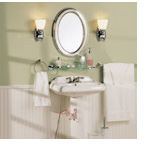 Bedroom
Bedroom Dining Room
Dining Room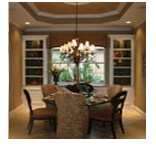 Kitchen
Kitchen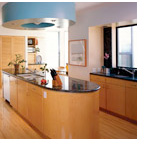 Living Room
Living Room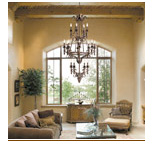 Outdoor
Outdoor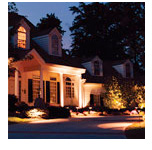
In the bathroom, you need plenty of even, shadow-free lighting for shaving, grooming, and applying makeup. In small bathrooms, mirror lights will illuminate the entire room, but in larger bathrooms, an additional ceiling fixture is needed for general lighting.
Wall-Mounted Fixtures can furnish general, task, and accent lighting. Many are designed to match and supplement dining room chandeliers, or to provide hallway, bedroom, or living room lighting. Wall brackets are often used for task lighting at the bathroom mirror. They are available with a choice of incandescent, tungsten-halogen, and energy-efficient compact fluorescent bulbs.
Please click on an image below to view a particular lighting tip.
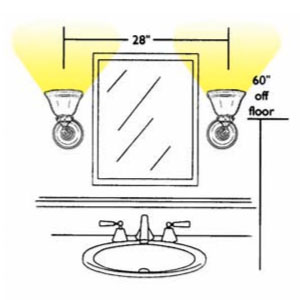
SMALL MIRROR
For small mirrors, decorative wall brackets on each side will illuminate both sides of your face evenly. You can also mount a wall bracket across the top of the mirror. A combination of the two will give you the most desirable light possible.
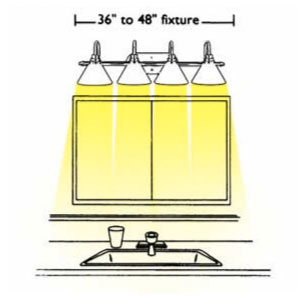
LARGE MIRROR
Fixtures equipped with standard incandescent, xenon or halogen bulbs behind glass globes provide the most flattering light. If you opt for more energy-efficient fluorescents, choose warm white tones. They come closest to the color of the incandescents.
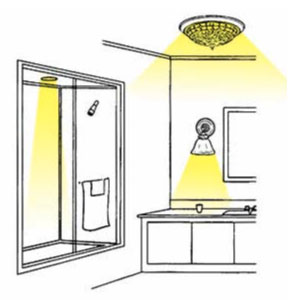
TUB AND SHOWER
Tub and shower enclosures can be adequately lighted by placing an enclosed damp-location recessed downlight in the ceiling. These downlights are also recommended over whirlpool baths or in saunas. Today, recessed lights are not only functional, but decorative as well.
Wall-Mounted Fixtures can furnish general, task, and accent lighting. Many are designed to match and supplement dining room chandeliers, or to provide hallway, bedroom, or living room lighting. Wall brackets are often used for task lighting at the bathroom mirror. They are available with a choice of incandescent, tungsten-halogen, and energy-efficient compact fluorescent bulbs.
Please click on an image below to view a particular lighting tip.

For small mirrors, decorative wall brackets on each side will illuminate both sides of your face evenly. You can also mount a wall bracket across the top of the mirror. A combination of the two will give you the most desirable light possible.

Fixtures equipped with standard incandescent, xenon or halogen bulbs behind glass globes provide the most flattering light. If you opt for more energy-efficient fluorescents, choose warm white tones. They come closest to the color of the incandescents.

Tub and shower enclosures can be adequately lighted by placing an enclosed damp-location recessed downlight in the ceiling. These downlights are also recommended over whirlpool baths or in saunas. Today, recessed lights are not only functional, but decorative as well.
When lighting a bedroom, you will want to create an overall atmosphere of quiet relaxation, while providing some bright spots for reading and other activities. A combination of general and task lighting that takes into account the age and lifestyle of the occupant(s) is needed. Remember, dimming controls give you the flexibility to vary the light to suit different moods and activities.
Wall-Mounted Fixtures can furnish general, task, and accent lighting. Today's choices of wall-mounted fixtures is vast. You can select a decorative theme that can be carried throughout the home or a look designed to blend into your bedroom decor.
Semi Flush or Ceiling Fixtures provide general lighting. They are practical in areas such as foyers, hallways, bedrooms, kitchens, baths, laundry rooms, playrooms, and dens. They are available with incandescent, fluorescent, halogen, xenon, and energy-efficient compact fluorescent bulbs.
Please click on an image below to view a particular lighting tip.
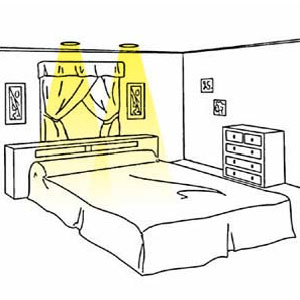
RECESSED LIGHTING
Another idea is to hang pendants next to the bed, or install recessed downlights in the ceiling over the bed. A way of directing light over the top of the bed is to properly place two recessed lights independently switched to control each light individually.
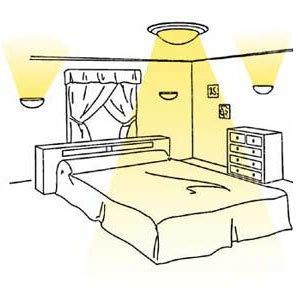
GENERAL LIGHTING
General lighting can be provided by ceiling fixtures, chandeliers, fan lights, recessed downlights, or wall sconces, giving you the illumination you need to dress and see into drawers and closets.
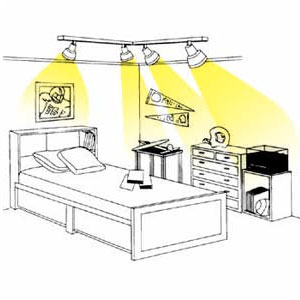
CHILD'S ROOM LIGHTING
Children's rooms will benefit from the use of properly placed track lights, which can be swiveled, rotated, and aimed in a direction to shed light on play areas, hobbies, or homework. As the child grows older, the fixtures can be moved and redirected toward a stereo cabinet or sitting area.
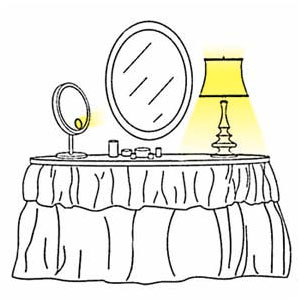
DRESSING TABLE LIGHTING
At the dressing table, a table lamp along with a lighted magnifying mirror will provide ideal lighting for grooming and applying makeup.
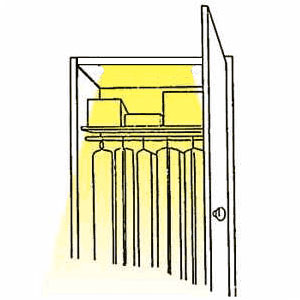
CLOSET LIGHTING
For closets, a surface mounted flourescent at the top of the header on the inside of the closet is recommended. This will give you safe even illumination on the inside of the closet from the shelf all the way to the ground.
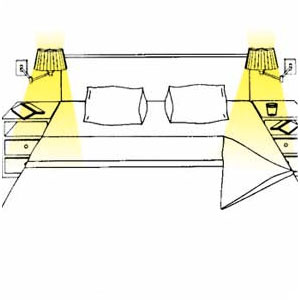
READING LIGHTING
Swing-arm wall lamps on either side of the bed will provide adequate light for reading, while leaving night tables free for a clock-radio, books, or beverages.
Wall-Mounted Fixtures can furnish general, task, and accent lighting. Today's choices of wall-mounted fixtures is vast. You can select a decorative theme that can be carried throughout the home or a look designed to blend into your bedroom decor.
Semi Flush or Ceiling Fixtures provide general lighting. They are practical in areas such as foyers, hallways, bedrooms, kitchens, baths, laundry rooms, playrooms, and dens. They are available with incandescent, fluorescent, halogen, xenon, and energy-efficient compact fluorescent bulbs.
Please click on an image below to view a particular lighting tip.

Another idea is to hang pendants next to the bed, or install recessed downlights in the ceiling over the bed. A way of directing light over the top of the bed is to properly place two recessed lights independently switched to control each light individually.

General lighting can be provided by ceiling fixtures, chandeliers, fan lights, recessed downlights, or wall sconces, giving you the illumination you need to dress and see into drawers and closets.

Children's rooms will benefit from the use of properly placed track lights, which can be swiveled, rotated, and aimed in a direction to shed light on play areas, hobbies, or homework. As the child grows older, the fixtures can be moved and redirected toward a stereo cabinet or sitting area.

At the dressing table, a table lamp along with a lighted magnifying mirror will provide ideal lighting for grooming and applying makeup.

For closets, a surface mounted flourescent at the top of the header on the inside of the closet is recommended. This will give you safe even illumination on the inside of the closet from the shelf all the way to the ground.

Swing-arm wall lamps on either side of the bed will provide adequate light for reading, while leaving night tables free for a clock-radio, books, or beverages.
Dining room lighting should be both beautiful and functional. This requires a mix of general, task, and accent lighting that can set the mood for a number of functions, including a formal dinner, a family get-together, and other activities such as homework, hobbies, or family bookkeeping. Dimming controls will enable you to vary the light for each occasion.
Chandeliers can add sparkle and style to your dining room while giving you the general lighting you need for dining and entertaining. Chandeliers can have either direct or indirect light. From traditional to contemporary, the choices of finish, light source and style make it easy to find the perfect fixture for your decor. The addition of a dimmer control lets you alter the intensity of light to suit the mood and activity.
Please click on an image below to view a particular lighting tip.
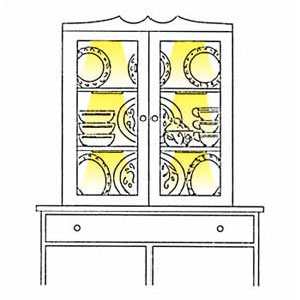
CHINA CABINET LIGHTING
A China cabinet, breakfront, hutch, or wall niche can become a showplace for your prized collectibles by installing lighting that is correctly placed within the unit.
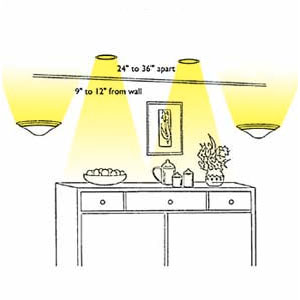
BUFFET LIGHTING
A buffet or sideboard can be flanked with wall sconces on either side. Choose fixtures that complement the style of your chandelier. Displayed objects can be accented with recessed downlights installed in the ceiling above.
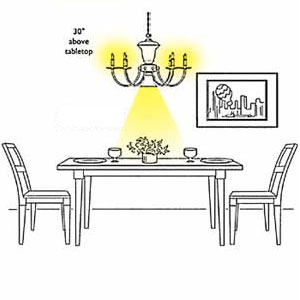
CHANDELIER LIGHTING
A chandelier is the focal point of the dining room. Suspended over the dining table, it serves as a decorative style element that enhances the beauty of your fine furnishings. WHen the light is dimmed, a soft glowing atmosphere similar to candlelight is created. In selecting the correct size of your chandelier, and easy rule of thumb is to take the length and the width of the room and add them. Example: For a 14'x16' room. you would look for a chandelier approximately 30" wide. The height of the ceiling and type of chandelier will also help to determine the correct size.
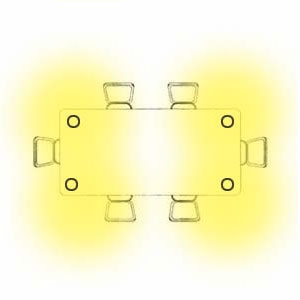
RECESSED LIGHTING
Recessed or track lighting provides general lighting, while enabling you to highlight prized possessions throughout the room. A ring of four recessed downlights around the dining table supplements the light from the chandelier, while providing accent lighting for your tableware. The pure white light of low-voltage fixtures with tungsten-halogen bulbs will make your crystal and silverware sparkle.
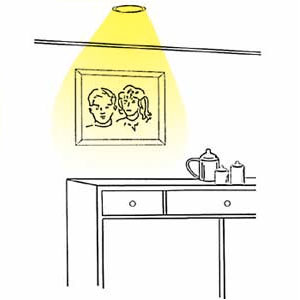
PORTRAIT LIGHTING
A family portrait can be dramatically lighted with recessed adjustable accent fixtures. Ask our lighting experts to help you choose fixtures that are best suited for this purpose.
Chandeliers can add sparkle and style to your dining room while giving you the general lighting you need for dining and entertaining. Chandeliers can have either direct or indirect light. From traditional to contemporary, the choices of finish, light source and style make it easy to find the perfect fixture for your decor. The addition of a dimmer control lets you alter the intensity of light to suit the mood and activity.
Please click on an image below to view a particular lighting tip.

A China cabinet, breakfront, hutch, or wall niche can become a showplace for your prized collectibles by installing lighting that is correctly placed within the unit.

A buffet or sideboard can be flanked with wall sconces on either side. Choose fixtures that complement the style of your chandelier. Displayed objects can be accented with recessed downlights installed in the ceiling above.

A chandelier is the focal point of the dining room. Suspended over the dining table, it serves as a decorative style element that enhances the beauty of your fine furnishings. WHen the light is dimmed, a soft glowing atmosphere similar to candlelight is created. In selecting the correct size of your chandelier, and easy rule of thumb is to take the length and the width of the room and add them. Example: For a 14'x16' room. you would look for a chandelier approximately 30" wide. The height of the ceiling and type of chandelier will also help to determine the correct size.

Recessed or track lighting provides general lighting, while enabling you to highlight prized possessions throughout the room. A ring of four recessed downlights around the dining table supplements the light from the chandelier, while providing accent lighting for your tableware. The pure white light of low-voltage fixtures with tungsten-halogen bulbs will make your crystal and silverware sparkle.

A family portrait can be dramatically lighted with recessed adjustable accent fixtures. Ask our lighting experts to help you choose fixtures that are best suited for this purpose.
The kitchen is primarily a work area, but it is also a gathering place for family and friends. Lighting that is comfortable as well as functional is required.
Undercabinet/ Undershelf Fixtures offer both task and accent lighting. Under kitchen cabinets are designed to light a countertop. In a display cabinet they show off prized possessions. They're used in a workshop or anywhere you need lighting right at hand. They include slim, energy-efficient fluorescents, miniature track lighting, and slim low-voltage mini-lights.
Pendants can provide both task and general lighting. They can be either standard, incandescent, xenon, halogen indirect or direct lighting with shades or globes to avoid glare, and they are suspended from the ceiling over dinette tables, game tables, kitchen counters, or other work areas. The use of a dimmer control gives you the flexibility to vary the light to suit the occasion. The use of mini pendants has become very popular from both a good lighting perspective, as well as to bring together the rest of the room.
Please click on an image below to view a particular lighting tip.
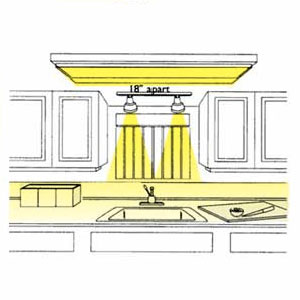
CEILING LIGHTING
A large ceiling fixutre, equipped with energy-efficient fluorescent tubes will supply plenty of well-diffused general lighting, but it may leave you working in your own shadow at the sink, range, and countertops. These areas need supplemental task lighting. For example, two track lights or recessed lighting over the sink will give the illumination you need for washing dishes and scouring pots and pans. Recessed lighting well placed in a kitchen can give fantastic task lighting. This, in combination with other task lighting, can be both beautiful and functional.
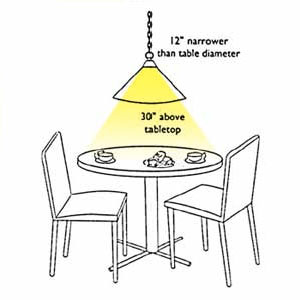
DINETTE/ISLAND LIGHTING
Dinettes, nooks, and island counters can be lighted with decorative pendants. When used with a dimmer control, these ceiling-hung fixtures will provide adequate task lighting for homework, hobbies, or family business and allow you to adjust the light for dining or entertaining.
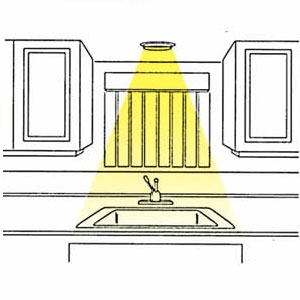
SINK & RANGE LIGHTING
At the sink and range, an individual recessed downlight, equipped with the correct bulb, will provide adequate task lighting when installed in the ceiling or in soffits over these two busy work areas.
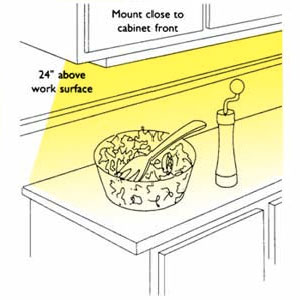
UNDERCABINET LIGHTING
Undercabinet lighting is ideal for countertops. They should be mounted as close to the front of the cabinets as possible to avoid glare reflecting off work surfaces. Choose from today's most popular light sources, such as xenon, halogen, or fluorescent. The size of the fixture will depend upon the light source you select.
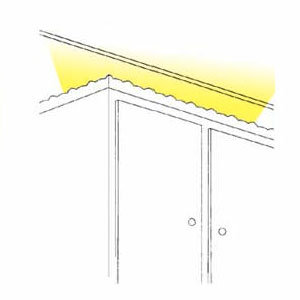
SOFFIT LIGHTING
Soffits and other concealed locations can also be treated effectively with these various types of lighting. These inconspicuous light fixtures will highlight your cabinetry, while adding a warm comfortable atmosphere to your kitchen.
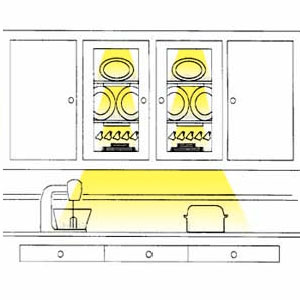
CABINET LIGHTING
Kitchen cabinets can be accuntuated by placing lighting on the tops, under, or inside of cabinets. With the incredibly wide array of different types of lighting fixtures available, you may use a variety of fixtures depending upon the exact application.
Undercabinet/ Undershelf Fixtures offer both task and accent lighting. Under kitchen cabinets are designed to light a countertop. In a display cabinet they show off prized possessions. They're used in a workshop or anywhere you need lighting right at hand. They include slim, energy-efficient fluorescents, miniature track lighting, and slim low-voltage mini-lights.
Pendants can provide both task and general lighting. They can be either standard, incandescent, xenon, halogen indirect or direct lighting with shades or globes to avoid glare, and they are suspended from the ceiling over dinette tables, game tables, kitchen counters, or other work areas. The use of a dimmer control gives you the flexibility to vary the light to suit the occasion. The use of mini pendants has become very popular from both a good lighting perspective, as well as to bring together the rest of the room.
Please click on an image below to view a particular lighting tip.

A large ceiling fixutre, equipped with energy-efficient fluorescent tubes will supply plenty of well-diffused general lighting, but it may leave you working in your own shadow at the sink, range, and countertops. These areas need supplemental task lighting. For example, two track lights or recessed lighting over the sink will give the illumination you need for washing dishes and scouring pots and pans. Recessed lighting well placed in a kitchen can give fantastic task lighting. This, in combination with other task lighting, can be both beautiful and functional.

Dinettes, nooks, and island counters can be lighted with decorative pendants. When used with a dimmer control, these ceiling-hung fixtures will provide adequate task lighting for homework, hobbies, or family business and allow you to adjust the light for dining or entertaining.

At the sink and range, an individual recessed downlight, equipped with the correct bulb, will provide adequate task lighting when installed in the ceiling or in soffits over these two busy work areas.

Undercabinet lighting is ideal for countertops. They should be mounted as close to the front of the cabinets as possible to avoid glare reflecting off work surfaces. Choose from today's most popular light sources, such as xenon, halogen, or fluorescent. The size of the fixture will depend upon the light source you select.

Soffits and other concealed locations can also be treated effectively with these various types of lighting. These inconspicuous light fixtures will highlight your cabinetry, while adding a warm comfortable atmosphere to your kitchen.

Kitchen cabinets can be accuntuated by placing lighting on the tops, under, or inside of cabinets. With the incredibly wide array of different types of lighting fixtures available, you may use a variety of fixtures depending upon the exact application.
When designing a lighting plan for a living room or family room, you need to consider the variety of activities that occur there. You'll want to include general lighting for entertaining and watching television, task lighting for reading or sewing, and accent lighting for artwork, plants, and interesting architectural features. Dimming controls are ideal for the living room because they allow you to design the lighting to suit each mood and activity.
Portable Lamps can deliver general, task, and accent lighting, while giving you the flexibility to move the light whenever you want. Table lamps, floor lamps, and torchiers are available in a variety of styles to complement any decor. Small specialty lamps, such as clip-on lights, uplight cans, adjustable task lights, mini-reflector spotlights, desk and piano lamps fill a variety of task and accent light needs. These lamps are available with incandescent, tungsten-halogen, and energy-efficient compact fluorescent bulbs.
Please click on an image below to view a particular lighting tip.
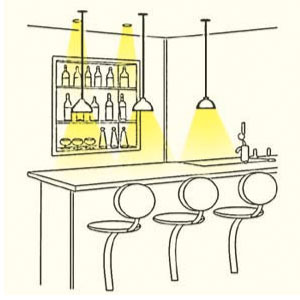
BAR LIGHTING
Bars can be lighted from above with recessed or track fixtures, or with miniature pendants that hover intimately over the bar.
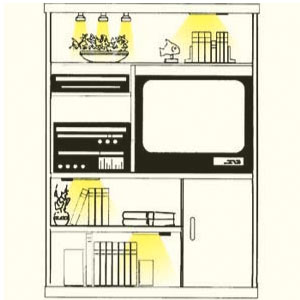
TV LIGHTING
Glass shelves and glassware can be accented recessed adjustable fixtures or lighting within the unit. The use of low-voltage fixtures with xenon or halogen bulbs will emit a bright white light that will highlight what you want to accent.
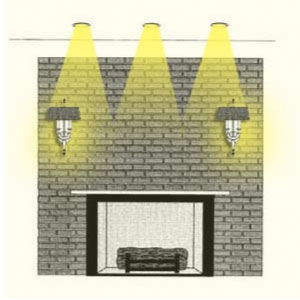
FIREPLACE LIGHTING
Fireplaces made of brick or stone can be emphasized with properly placed recessed downlights installed in the ceiling over the mantle to create an intriguing grazing effect across the surface. Wall sconces can be installed directly on the fireplace and are an attractive addition that draws attention to the fireplace area, while providing general lighting for the living room.
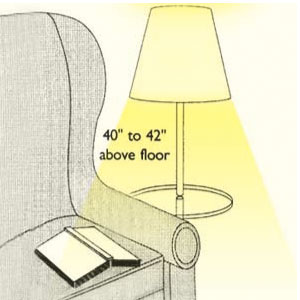
READING LIGHTING
reading requires task lighting that comes from behind the reader's shoulder. This can be accomplished by placing a floor lamp either at the right or the left of the reading chair. The bottom of the shade should be located at eye level to avoid glare.
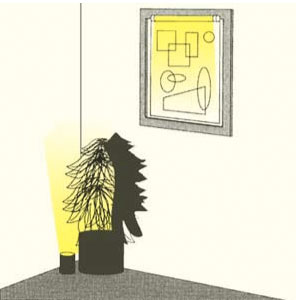
PAINTING/PLANT LIGHTING
Paintings can be highlighted with xenon or halogen picture lights. These lights should be mounted to spread a beam of bright, white light across the face of the painting.
House Plants can be accented by aiming an uplight can at the wall behind the plant, creating a dramatic siloutte of the plant against the wall.
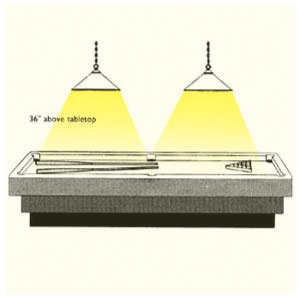
GAME TABLE LIGHTING
Game tables require bright, even overhead lighting. Shaded pendants equipped with either incandescent bulbs or energy-efficient compact fluorescent tubes are one solution (see illustration). Or, install two recessed downlights over each half of the table.
Portable Lamps can deliver general, task, and accent lighting, while giving you the flexibility to move the light whenever you want. Table lamps, floor lamps, and torchiers are available in a variety of styles to complement any decor. Small specialty lamps, such as clip-on lights, uplight cans, adjustable task lights, mini-reflector spotlights, desk and piano lamps fill a variety of task and accent light needs. These lamps are available with incandescent, tungsten-halogen, and energy-efficient compact fluorescent bulbs.
Please click on an image below to view a particular lighting tip.

Bars can be lighted from above with recessed or track fixtures, or with miniature pendants that hover intimately over the bar.

Glass shelves and glassware can be accented recessed adjustable fixtures or lighting within the unit. The use of low-voltage fixtures with xenon or halogen bulbs will emit a bright white light that will highlight what you want to accent.

Fireplaces made of brick or stone can be emphasized with properly placed recessed downlights installed in the ceiling over the mantle to create an intriguing grazing effect across the surface. Wall sconces can be installed directly on the fireplace and are an attractive addition that draws attention to the fireplace area, while providing general lighting for the living room.

reading requires task lighting that comes from behind the reader's shoulder. This can be accomplished by placing a floor lamp either at the right or the left of the reading chair. The bottom of the shade should be located at eye level to avoid glare.

Paintings can be highlighted with xenon or halogen picture lights. These lights should be mounted to spread a beam of bright, white light across the face of the painting.
House Plants can be accented by aiming an uplight can at the wall behind the plant, creating a dramatic siloutte of the plant against the wall.

Game tables require bright, even overhead lighting. Shaded pendants equipped with either incandescent bulbs or energy-efficient compact fluorescent tubes are one solution (see illustration). Or, install two recessed downlights over each half of the table.
Outdoor lighting enhances the beauty of your property, makes your home safer and more secure, and increases the number of pleasurable hours you spend outdoors. And it is an investment that pays off handsomely in the value it adds to your home.
For added security, illuminate any side of the house that would otherwise be in shadow. To conserve energy, install a motion or heat-sensitive control that will switch on the light only if someone approaches that side of the house. An automatic timer can control a portion of your outdoor lights to turn off at a certain hour, while basic security lights can be left on through the night. Another proven safety measure is to use timers on interior lights to make your home look occupied when you're away.
Dark-Sky Friendly Lighting Tip
In order to prevent unwanted glare from your outdoor lighting, use bulbs with reasonable illumination levels. You may also use full cut-off fixtures to direct the light down towards the ground, where it is needed, rather than being cast to the side or up towards the sky, where it is wasted.
Please click on an image below to view a particular lighting tip.
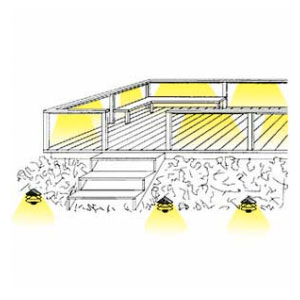
DECK/PORCH LIGHTING
Decks, porches, and patios can be converted into romantic evening retreats by concealing low-voltage mini-lights under steps, railing, or benches.
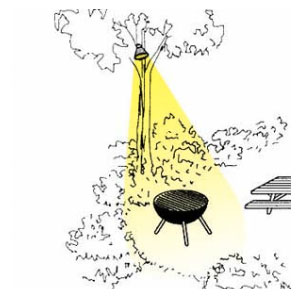
SPOTLIGHTS
Another Idea is to install a spotlight in the branches of a nearby tree.
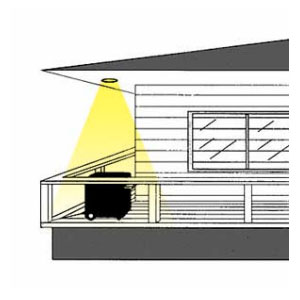
BARBAQUE LIGHTING
Dont't forget to add stronger light over the barbaque or serving area. To accomplish this, install a recessed spot-light on an adjacent roof overhang or mount spread lights on a railing behind the grill.

DRIVEWAY LIGHTING
Steps, paths, and driveway lights are simple to install and can easily be moved to reflect changes in your landscaping. Low-level path lights can also be used to define the boundaries of long driveways. Bollards or cut down pole lights which stand 30 to 36 inches off the ground also work well.
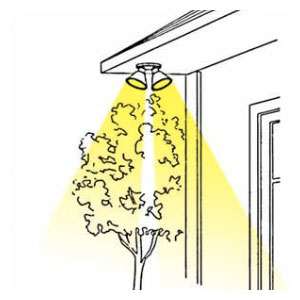
SECURITY LIGHTING
For added security, illuminate any side of the house that would otherwise be in shadow. To conserve energy, install a wall timer, a motion or heat-sensitive control that will switch on the light only if someone approaches that side of the house.
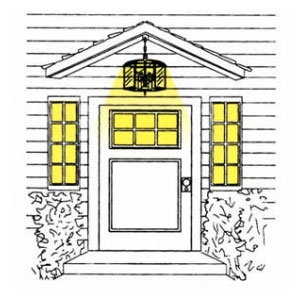
OVERHANG LIGHTING
Under a porch or other overhang, you can use recessed, chain-hung, or close-to-ceiling fixtures. A separate rear or side entrance can be lighted with a single wall lantern installed on the keyhole side of the door. To conserve energy, consider post and wall lanterns that use new compact fluorescent or high-intensity discharge light sources such as mercury vapor or high pressure sodium.
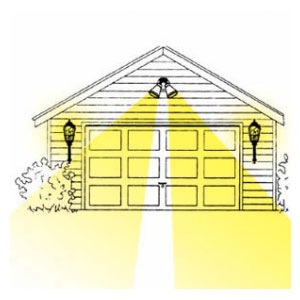
GARAGE LIGHTING
For the safety and security of family members, using the garage at night, you can install a wall fixture above or to either side of the garage doors. Motion detectors light up obscure spots when someone passes by. In addition, photocells are available that will turn fixtures on at dusk and off at dawn, reducing energy consumption and providing security when you're away from home.
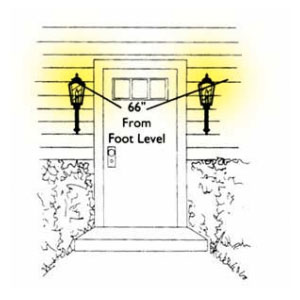
ENTRANCE LIGHTING
A well-lighted front entrance enables you to greet guests and identify visitors. Wall lanterns on each side of the door will give your home a warm, welcoming look, while assuring the safety of those who enter.
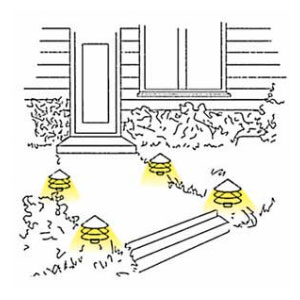
PATH LIGHTING
Steps, paths, and driveways should be illuminated to make sure family members and guests are able to move easily and safetly after dark. You can install path lights or post lanterns, or attach lights to the side of the house. Low-level path lights, which spread circular patterns of light, will brighten your walkway, while highlighting nearby flower beds, shrubs, and ground cover. These close-to-ground lights are available in fixtures using both low-voltage and line voltage current.
For added security, illuminate any side of the house that would otherwise be in shadow. To conserve energy, install a motion or heat-sensitive control that will switch on the light only if someone approaches that side of the house. An automatic timer can control a portion of your outdoor lights to turn off at a certain hour, while basic security lights can be left on through the night. Another proven safety measure is to use timers on interior lights to make your home look occupied when you're away.
Dark-Sky Friendly Lighting Tip
In order to prevent unwanted glare from your outdoor lighting, use bulbs with reasonable illumination levels. You may also use full cut-off fixtures to direct the light down towards the ground, where it is needed, rather than being cast to the side or up towards the sky, where it is wasted.
Please click on an image below to view a particular lighting tip.

Decks, porches, and patios can be converted into romantic evening retreats by concealing low-voltage mini-lights under steps, railing, or benches.

Another Idea is to install a spotlight in the branches of a nearby tree.

Dont't forget to add stronger light over the barbaque or serving area. To accomplish this, install a recessed spot-light on an adjacent roof overhang or mount spread lights on a railing behind the grill.

Steps, paths, and driveway lights are simple to install and can easily be moved to reflect changes in your landscaping. Low-level path lights can also be used to define the boundaries of long driveways. Bollards or cut down pole lights which stand 30 to 36 inches off the ground also work well.

For added security, illuminate any side of the house that would otherwise be in shadow. To conserve energy, install a wall timer, a motion or heat-sensitive control that will switch on the light only if someone approaches that side of the house.

Under a porch or other overhang, you can use recessed, chain-hung, or close-to-ceiling fixtures. A separate rear or side entrance can be lighted with a single wall lantern installed on the keyhole side of the door. To conserve energy, consider post and wall lanterns that use new compact fluorescent or high-intensity discharge light sources such as mercury vapor or high pressure sodium.

For the safety and security of family members, using the garage at night, you can install a wall fixture above or to either side of the garage doors. Motion detectors light up obscure spots when someone passes by. In addition, photocells are available that will turn fixtures on at dusk and off at dawn, reducing energy consumption and providing security when you're away from home.

A well-lighted front entrance enables you to greet guests and identify visitors. Wall lanterns on each side of the door will give your home a warm, welcoming look, while assuring the safety of those who enter.

Steps, paths, and driveways should be illuminated to make sure family members and guests are able to move easily and safetly after dark. You can install path lights or post lanterns, or attach lights to the side of the house. Low-level path lights, which spread circular patterns of light, will brighten your walkway, while highlighting nearby flower beds, shrubs, and ground cover. These close-to-ground lights are available in fixtures using both low-voltage and line voltage current.
